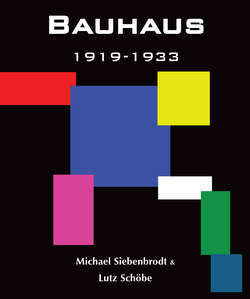Читать книгу Bauhaus. 1919-1933 - Michael Siebenbrodt - Страница 13
На сайте Литреса книга снята с продажи.
History of the Bauhaus
Bauhaus Dessau: Academy for Design (1925 to 1932)
The Bauhaus Becomes an Academy
ОглавлениеIn the autumn of 1926 – the new school building had not yet been opened – the constitution was published. From that time, the Bauhaus was recognised by the Anhalt state government as the Academy of Design. Thus the Masters were henceforth called professors and the pupils, who now had the opportunity to gain the Bauhaus diploma, became students. The aims of the school were clearly defined in the constitution: first, “to shape the intellectual, crafts and technical abilities of creatively-talented human beings to equip them for design work, particularly construction”, and second “to perform practical experiments, notably in housing construction and interiors, as well as to develop model types for industry and manual trades.”
The holistic and comprehensive Bauhaus pedagogy was continued and reinforced. In Weimar the institution had been regarded as a pedagogical project for which the prestigious School for Arts and Crafts was a forerunner. The city of Dessau had remarkable school traditions to offer as well. A 1927 edition of the newspaper Dessauer Zeitung effusively reminded its readers of a “… Dessau Bauhaus 130 years ago” and referred to the General Preparatory Education Establishment for Mechanical Trades and Fine Arts for Dessau planned by the classicist architect Friedrich Wilhelm von Erdmannsdorff (1736–1800) in the eighteenth century. The Dessau Philanthropin, one of the most important schools founded in the eighteenth century, can in the broadest sense be seen as a regional forerunner of the Bauhaus on the basis of noticeable intellectual correlations. The Dessau education system, too, did not remain uninfluenced in the following period by these rich educational, political and reformist pedagogical traditions. In the second half of the 1920s there was, for instance, talk of a time of “pedagogical reforms and new reorganisation”, while “student practical education, independence and self-administration, connection of individual subjects, physical education, [and] teacher co-operation” were seen as “new values”.[5] The Bauhaus, that experimental school from Weimar which was very aware of this tradition, was able to continue this.
Apart from preparatory courses and workshop education there was also more complex instruction in natural science subjects as well as sports at the Dessau Bauhaus. In 1927, Walter Gropius was finally successful in appointing the Swiss architect Hannes Meyer, who would subsequently build and head the architecture department. Finally it was officially possible to educate architects in a two-level programme involving the completion of a builder’s apprenticeship and work in the building studio. The lack of a building department or an architecture class as an appropriate conclusion of the Bauhaus curriculum had been recognised as a defect from the beginning. It was only later, with the establishment of an architecture department and the recognition of its academy status, that a renewed change of the teaching profile was brought about. Architecture was now above everything else. Almost all workshops were combined in the department of “Construction and Interior Furnishing.” The advertising and, finally, the theatre departments remained separate areas. To this the “Seminar for Free Sculpting and Painting Design” was added, a course which was mainly run by Wassily Kandinsky and Paul Klee and later continued as a “Free Painting Class.”[6]
5
Prof. Dr. Heine in: Anhalter Anzeiger dated 30.06.1932.
6
Bauhaus Dessau, Semester Plan 1927.
